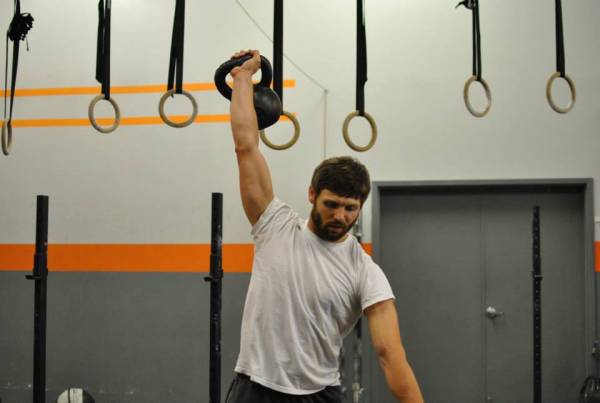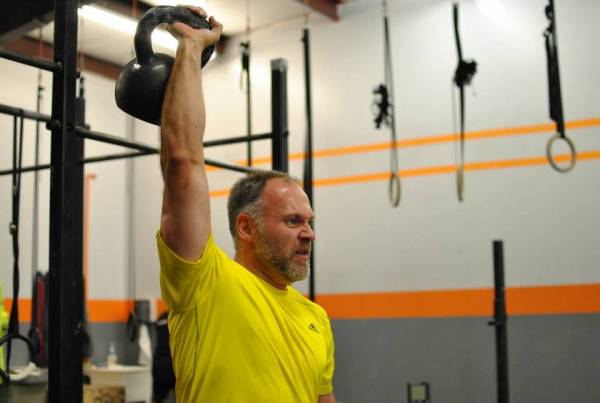When it comes to kettlebells, the snatch is often the first lift that many people want to learn. The reason for this isn’t clear to me. Perhaps it is that everyone thinks it is the hardest lift, as it is usually taught last to beginners. In much the same way that a barbell snatch has that appeal by being regarded as difficult, the kettlebell snatch has that same appeal by virtue of the fact that whipping a decent-sized kettlebell overhead for even a few reps will leave you breathing hard and wondering just what the hell happened to you. But let’s start at the start and figure out what the snatch is, and how best to build it.
The First Step to the Snatch Is the Swing
The first step with any kettlebell ballistic is to develop a sound swing. The swing is the central piece to this performance, and if it is not deeply ingrained then your snatch will never be any good. In fact, the first part of the testing standard for the snatch at the RKC is: “All of the points that apply to the swing, minus the requirement to keep a straight arm and the kettlebell float.” So, the best first step to learning the snatch for many is to go back and perform another few thousand one-arm swings.
The Second Step to the Snatch Is to Press and Get Up
The second step is to understand that jumping to the snatch quickly will usually make it hard to learn. Not surprisingly, many people have some innate fear of throwing a heavy weight overhead. This can be countered by spending ample time on both get ups and pressing. Both of these exercises build stability at the shoulder, as well as teach how to have the hand, wrist, and arm at lockout. Only once that position is well embedded in the mind is it worth asking someone to find it as speed as they start throwing the bell overhead. Without knowing exactly where the bell should land, asking a person to get the bell there is exactly like expecting someone who can’t even hold a handstand against a wall to kick up into a majestic handstand.
With new clients at Read Performance Training we usually don’t even teach them the snatch for the first few months of training. And by the time we do teach them the snatch, it takes very little time to grasp as they’ve already built most of the mechanics by grooving thousands of swings, and hundreds of presses and get ups. When you’ve got a solid start and end point, then filling in the bit in between is easy – just like starting a trip in the car is, if you know where you are and where you’re going.
What It Means to “Tame the Arc”
 Each ballistic move has it’s own arc, and you will often hear people speak of taming the arc. While a swing is completed with arms straight at all times the other two ballistic kettlebell moves are done with different degrees of arm bend. The kettlebell clean is actually done with the upper arm staying in contact against the sides the entire time, so its arc is extremely tight. If they actually still had telephone booths, you’d be able to do kettlebell cleans inside one, such is the compactness of the move.
Each ballistic move has it’s own arc, and you will often hear people speak of taming the arc. While a swing is completed with arms straight at all times the other two ballistic kettlebell moves are done with different degrees of arm bend. The kettlebell clean is actually done with the upper arm staying in contact against the sides the entire time, so its arc is extremely tight. If they actually still had telephone booths, you’d be able to do kettlebell cleans inside one, such is the compactness of the move.
But the arc of the snatch is halfway between the swing and the clean. The arm will be bent, but not so bent as to have a ninety-degree angle at the elbow. I’ll return to this shortly, and you can see it quite clearly in the video here:
The Fear of the Kettlebell Smack
The single biggest sticking point for people, after not having a good enough swing or a complete understanding of their lockout position, is knowing when and how the bell will travel around the hand. At some point, and it is entirely up to you, the kettlebell is going to end up on the back of your wrist. You can choose whether or not it is going to be controlled by you, or whether it is going to slam into your arm as hard and as fast as it possibly can.
If your snatch is more like a big swing – done with a straight arm – then at the top of the arc, with your arm vertical, that bell has no choice but to continue its journey until it is stopped by something. The problem for you is that because you’re snatching with a straight arm, the thing that’s going to stop the bell’s trajectory is the action of it whipping around your hand and slamming into your arm at the exact same speed you fired it overhead with your swing. I’m going to tell you now that this is not much fun, and it’s usually why you see people wearing wrist guards when they snatch – because their form is crappy and they haven’t been shown how to fix it.
Instead, if you focus pushing your hand around the handle of the bell, at about the point the bell passes your head, you’ll find that the bell comes to rest against your forearm far more gently. In essence, you catch the bell with the back of your forearm rather than get hit on the back of the forearm. The key to this movement is to shoot your hand through the handle. The action will look like a little kid shooting their hand into the air to ask a question in class.
Relax Your Grip and Save Your Hands
 The next big thing that often limits people is their hands tearing. I’m sure you’ve all seen pictures of people with torn up, bleeding hands. That’s their own fault and it should never happen. I’ve done thousands snatches per week for weeks straight and never hurt my hands. The key is in understanding that a kettlebell isn’t like a bar or dumbbell and doesn’t sit in your hands, but rather rotates constantly during each part of the lift. That means you can’t just choke the hell out of it, because when it spins in your hand you will actually end up doing more damage.
The next big thing that often limits people is their hands tearing. I’m sure you’ve all seen pictures of people with torn up, bleeding hands. That’s their own fault and it should never happen. I’ve done thousands snatches per week for weeks straight and never hurt my hands. The key is in understanding that a kettlebell isn’t like a bar or dumbbell and doesn’t sit in your hands, but rather rotates constantly during each part of the lift. That means you can’t just choke the hell out of it, because when it spins in your hand you will actually end up doing more damage.
At the bottom of the snatch, when the bell is between your legs, you barely need to be holding onto it – just enough so it doesn’t fall out of your grip, and with the weight of the bell at the base of the index finger. After you’ve fired the bell to the overhead position you also really don’t need to grip it. Just a caution: while many say that you should have an open hand with the fingers speared through the bell overhead, you cannot maximally fire your rotator cuff this way, as it is activated by grip. And I don’t know about you, but when I have 24kg of metal hurtling overhead I want to know my shoulder is as switched on as it can be. For that reason I will keep an active grip on the handle at this point. On the drop, there is also no great need to crush the handle and the goal should be to make the handle skip over the callus line, sparing that rotation in a tight grip that leads to tearing.
In all honesty, if you’ve spent the right amount of time on the swing, get up, and press, the snatch is an easy beast to tame. If, however, you try to jump to it too quickly, you’ll find that it bites back and likely ends up hurting you. Once you’ve got the basic elements under control, then it’s time to go get some reps in. Like with everything, mastery will not come instantly, and it will take some reps to get everything nice and smooth. As an example of how long this can take we often see people tear their hands during the snatch test at the RKC (five minutes to perform one hundred reps with either a 16kg bell for ladies or a 24kg for men). Yet when they come to recertify at a later date it’s uncommon to see anyone with torn hands – because they’ve gotten to the point where they really understand the technique.
Photo 1 courtesy of CrossFit LA.
Photos 2 & 3 courtesy of CrossFit Impulse.






